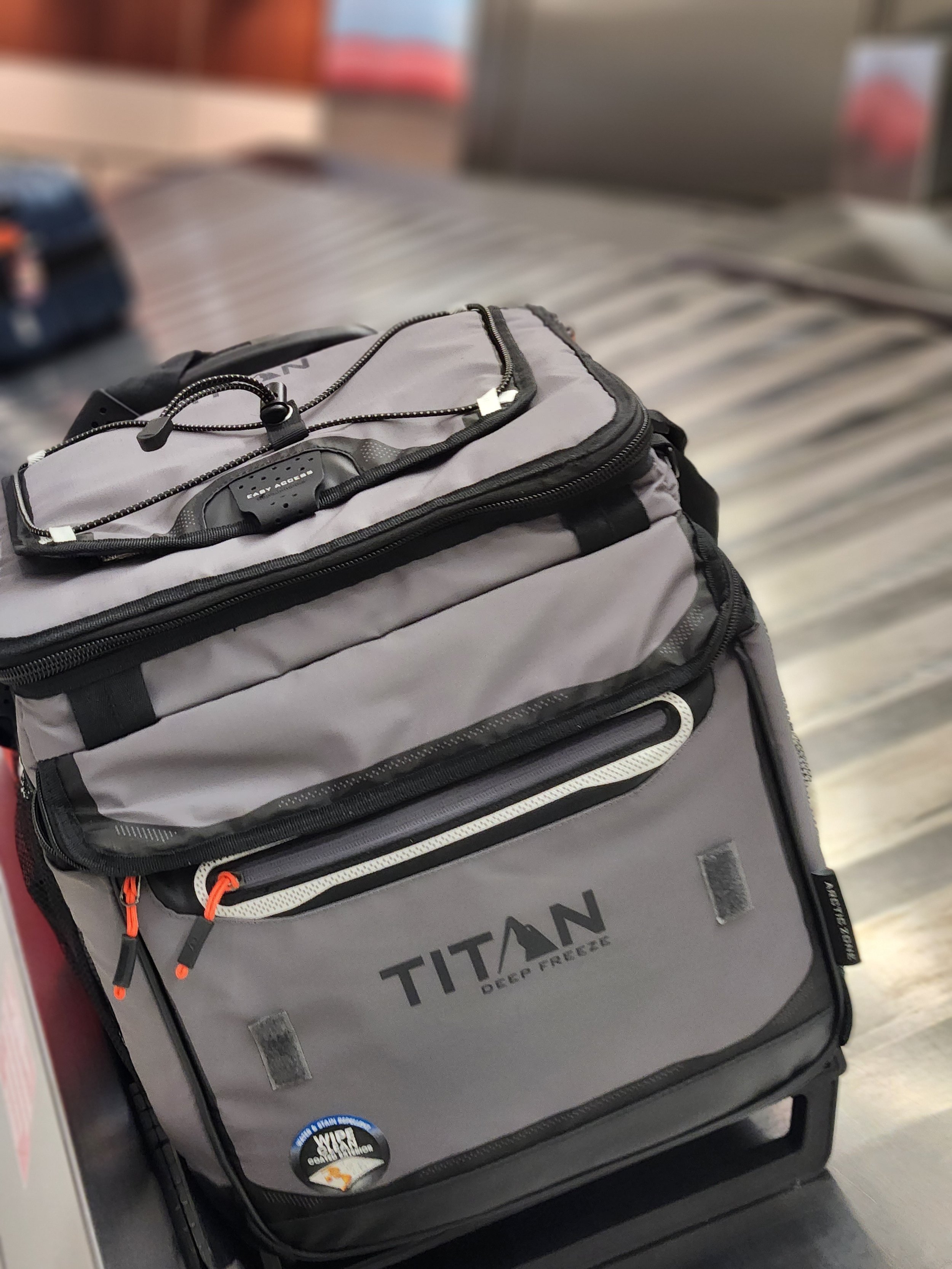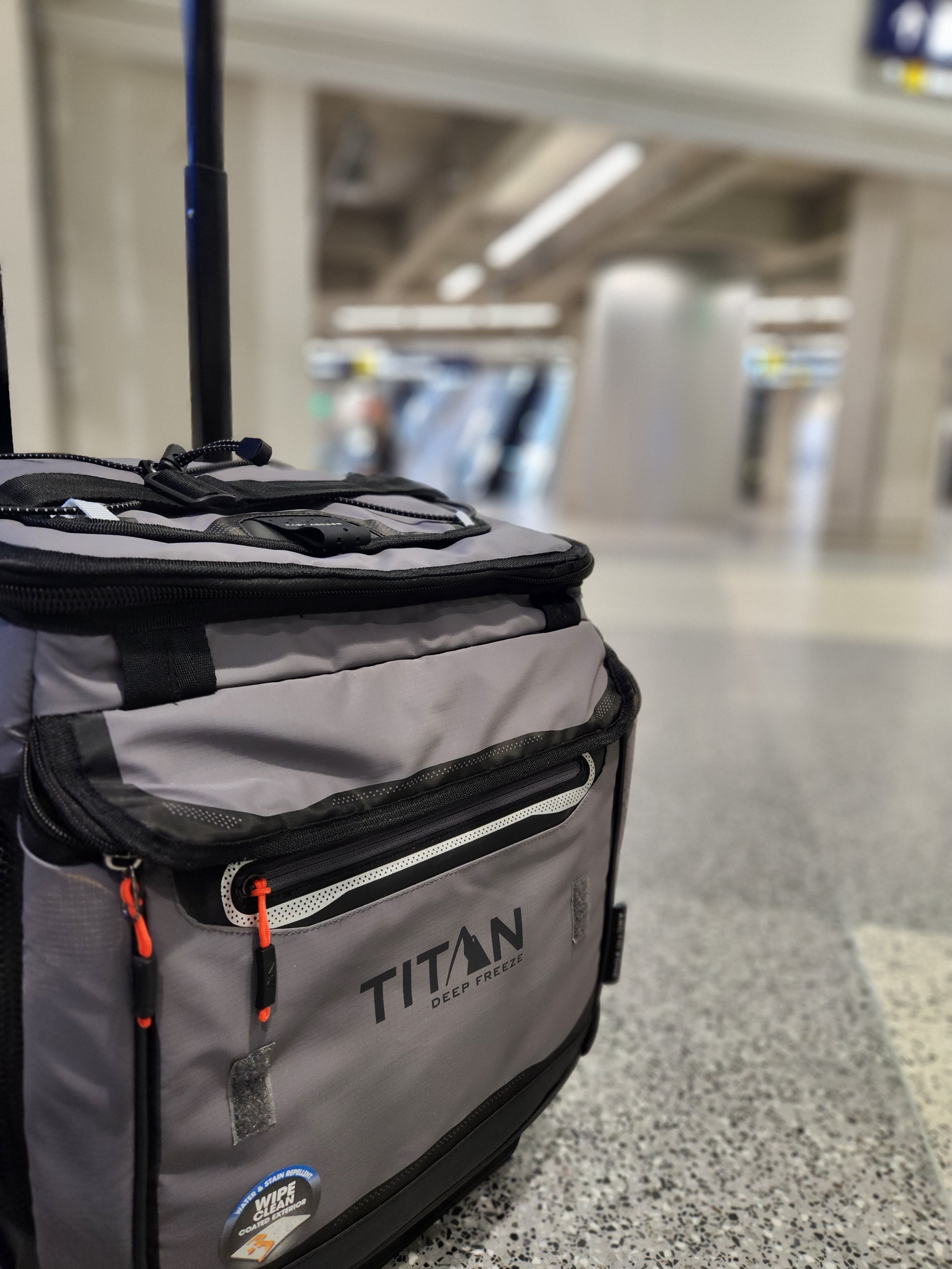It’s no secret that I love fishing wherever I can and feel strongly that fishing outside your comfort zone will make you a better angler, no matter the species. Yet, there’s a primary wrinkle in the framework of enjoying that catch, especially if you travel far and wide. Air travel or even length trips in the truck call for some specialized equipment and even more special treatment of the fish themselves. Though there may be no one-size-fits-all solution to traveling with a bag of fish fillets, here’s a few considerations to take into account.
Airline Travel
Though this may be the most challenging portion of the subject, it could be the most worthwhile. In the past few years alone, I’ve been faced with getting everything from halibult in Alaska back home, to blue crab and redfish from the Chesapeake bay. Each scenario posed its own challenges, primarily in the form of volume. In the AK example, we had nearly 70 pounds of salmon to come back as well, and in Virginia, I was looking at roughly 20 pounds. Let’s use these two examples to break down a few strategies.
In most instances, it pays to check a bag here, especially if you don’t pay to check said bag. Utilize an airline-specific credit card, promotional offers, or reasonable checked luggage prices from select airlines to permit the opportunity of a checked bag. In some cases, if you fly enough, you’ve got the option to check several bags, or at least one bag per person flying. If you have to utilize that checked bag for your traveling companions, it’s often worth the effort, which does require some pre-planning.
In recent trips, I’ve checked a cooler on the way out to my destination, and when I brought it back, ensured it was full of seafood. That comes of course with some hiccups too, from latches and sealing, to making sure you’re underweight when it comes to your checked coolers. In one instance, I was with a friend who flew Delta Platinum, and could carry up to 70 lbs. on each back, which was really handy for the salmon. As a Delta Gold member myself, I was able to carry 50 lbs. which works for most cases, provided the cooler isn’t too heavy in its own right.
We start by freezing all of our fillets solid in camp, preferably with a vacuum sealer if on hand. Then, take careful note to separate the fillets and lay them out in the camp freezer, again if possible. Singular, individually packaged groups of fillets when layed out in this way freeze more solid, and therefore stay better frozen when traveling. Still, unless you’re filling the cooler to the top with fillets, it’s best to at least fill empty space with towels, a random hoodie, or large frozen chunks of ice where available.
Soft-sided Coolers with extendable handles and wheels make airport travel easier.
I’m a big fan of hard-side coolers when it’s possible to use them, for a number of reasons. Durability is but one, but the ability of a well-insulated, hard-side cooler to keep frozen items frozen over a longer duration is probably the chief concern for most anglers. Still, the roto-molded, ultra-insulated varieties both take up valuable checked luggage space, but also are heavy. For that reason, you may need to go with a quality soft-sided cooler, or a smaller hard-side that both permits some volume of fish, while also staying light-enough in weight to not exceed your checked baggage standard. Of course, there’s always the rugged and reliable cheaper hardside coolers. I’ve used those before too, though most do not have wheels (which is a challenge in an airport), and the latches rarely stand up to long-term use. For that reason, we have often completely duct taped the entire cooler lid to the cooler in multiple spots. Not only does it keep the lid secure, it notifies you if anyone has tampered with your luggage.
Truck Travel
This option is probably more familiar to most people but does also take some considerations. I’m typically traveling across country, and tend to keep two coolers onboard when fishing. I keep a smaller rotomolded option in the back of the crew-cab for snacks, drinks, and anything like smoked fish I may pick up on the way, and I keep a larger cooler under the tonneau cover of my truck for volume. It’s amazing how nice this 1 -2 cooler punch works out when taking big trips, and the options you have for a variety of fish and game.
The smaller cooler in the cab is stocked from home with soda, water, and a variety of refrigerated snacks that keep me from having to make costly stops to gas stations that have the same items at a mark-up. On longer trips where I’m often in charge of my own breakfasts and/or lunch, I’ll stop at a grocery store at our destination and fill up the bigger cooler in the back with just enough to get me buy a number of those meals. Usually, if I am taking home fish, I have already cleaned out the big cooler, or can put extras in the small one, and, I’ve created space for the fillets I intend to get home.
Keep in mind that some states require a skin patch per fillet or so for identification, so it can be best in those instances not to freeze fish while at your destination. Instead, keep them on plenty of ice throughout the length of your stay, and consider keeping fish only the last day or so of your trip to ensure the freshest meal possible. Regular ice does the trick, but I find that large frozen milk jugs will extend your cooling over a couple of days, even in really hot weather. That, and it extends the duration that your smaller cubes stay whole in the cooler as well.
Often, I’ll keep my fillet kit inside a one-gallon Ziploc bag and stow that in the big cooler as well. This kit usually consists of a larger and smaller fillet knife, plenty quart and gallon sized freezer bags, and some specialized soap to get fishy smell off your hands (individually packed in its own plastic). I always keep this in the truck, as I never know when I might need to fillet some fish, and there are times where I’ll even bring an electric knife and/or a vacuum sealer if I intend to run into and keep larger quantities of fish.
It's amazing how easy it is to keep a few fish at any destination, especially if you’re prepared. At the same time, I’m also mindful of not necessarily focusing on a “limit” wherever I go. Fish are a nice treat for me, but rarely the highlight or the sole mission on any adventure. Even at the fish-factory type lakes where mechanized fillet harvesting is as much a business as the fishing itself, I’m content to enjoy some fish dinners at the lodge and maybe not take any fish home at all. Regardless of which suits you best, going into it with a plan makes for an easier effort all around.










